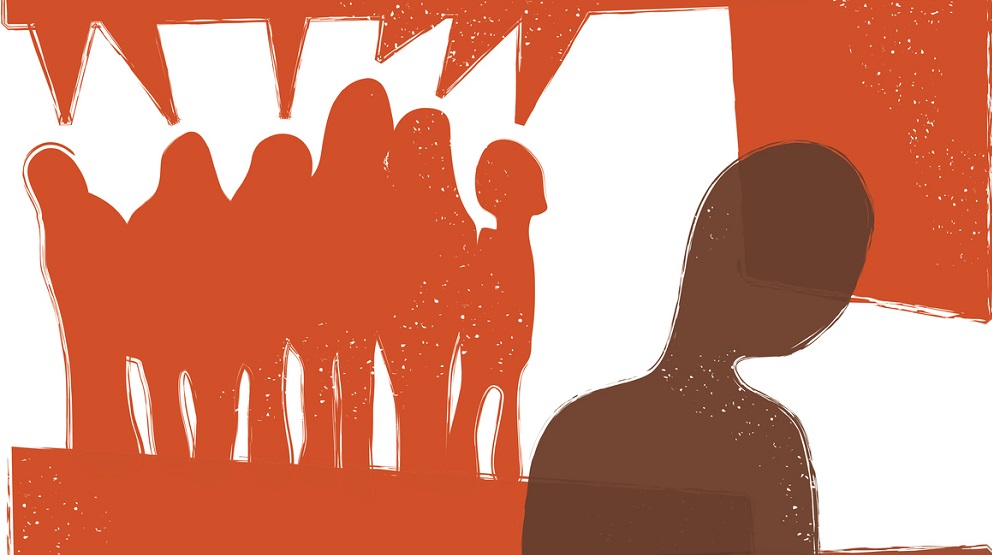This guest post by Rosebell Kagumire originally appeared on the African Feminism (AF) blog. It is part of a 3-part series on the #AidToo experiences of African women, which the creators hope will “encourage more African women to speak up, and encourage those in the leadership echelons of development organizations to begin to reflect on aligning externally held values with how they enact them individually and collectively.” Also see reflections from Bethel Tsegaye here and Lydia Namubiru here.
I am a firm believer in making journeys, taking steps far out of my comfort zone for the sake of learning and seeking new experiences. That is for both physical and intellectual spaces. So when an opportunity to work with a major international non-governmental organization (INGO) came up for short term, I packed my bags and headed to Europe. This wasn’t much about the big money we are made to believe is what awaits you there. The pay was decent, but what no one prepares you for and what is rarely talked about in depth, is what it means to be an African in an institution operated by a white majority. Growing up in Uganda and working mainly in the Great Lakes region of East Africa, I had not much an idea of what this would mean. While I was aware of the dynamics in the development sector back home (as satirically depicted in this film NGO : Nothing Going On directed by Arnold Aganze, a filmmaker originally from Eastern Congo), I was yet to experience life as a minority.
At the international level, we have seen tables shake in the last few months since the revelations of the Oxfam sex scandal in Haiti, where international NGO workers paid local women for sex. Following this storm and a few other high profile abuse cases in the international aid sector, Angela Bruce-Raeburn, the former Senior Policy Advisor for the Humanitarian Response in Haiti at Oxfam America, penned one of the most relatable responses. In ‘But wait until they see your black face‘ looking at inclusion and racism in the sector, I found resonance. And the responses of other black women in the sector about mental gymnastics and marginalization one has to engage in to survive, were all too familiar.
Why is it familiar? I have worked with international agencies as a consultant at different times. By the time I joined one of the organizations, I was well aware of the need for agency of local people in the organizations [where] they worked. I was already loud about the caricatures we get used to in the media about people in need. So when I got called to work on migrants rights, it was an opportunity to immerse myself in one of the greatest challenges states across the world are facing – forced migration. But neither my education in gender and media, nor experiences in short visits abroad, nor one year of living in a foreign country, would have prepared me for this scenario.
 Working as an African woman/Black woman in a majority white and male organization, I would later learn that I had arrived at a time when there was push for diversity, not inclusion. From the way my supervisor showed me off to management, it was about him getting a qualified African woman in – something he wanted to be recognized for, instead of this being required practice.
Working as an African woman/Black woman in a majority white and male organization, I would later learn that I had arrived at a time when there was push for diversity, not inclusion. From the way my supervisor showed me off to management, it was about him getting a qualified African woman in – something he wanted to be recognized for, instead of this being required practice.
In fact a few months after my arrival in an all white communications department, we were joined by two brilliant recruits – one Kenyan and another South Sudanese. To keep getting his credit from top management, one time my supervisor stopped the only African top manager in the corridors and called the three of us to show him his African recruits. I had no idea whether he was oblivious of what he was doing, or if this was how he gets marks, but this was the first sign that things would not go well. In any case, we exchanged odd smiles with the manager and went back to work.
I had never been showed off in a workplace to someone simply because of the colour of my skin.
When one of the African recruits could not deliver a strategy at short notice – unreasonable given the person had not even finished orientation – the supervisor came to my office to ask me to tell this communication assistant that “if she did not have her strategy by end of the day she will be on the next plane back to her country.” Before this day, no amount of bullying from the supervisor had ever broken me. This blatant racism and insensitivity made me close my office door and I wept. I wept because this African he was abusing had escaped war and still maintained her sanity, and had come with a masters degree to offer her skills, only to be met with a man like this. I wept because I could not bring myself to tell my African colleague. I thought it was my duty to protect her from such vile.
My supervisor was a European white male who had never been to Africa or the Arab world, but was ‘well suited’ to speak for experiences of migrants. And you know who make up a good number of migrants – “poor Africans” – as I heard on several occasions. And not forgetting the random questions about which African proverb fitted what situation. To this man, we were his African consultants, not people with skills and rightly deserving of doing our work.
To make matters worse, there was a very unclear relationship with the only white woman on the team. I say unclear because everything this white woman brought up in the meeting had to be taken up. In fact, one time this woman suggested I attend a certain meeting that I didn’t really think was a priority, as I had lots of work on my table that day. However, within the next thirty minutes, I had the supervisor on my door demanding that I go and that I cannot say no to the white lady. It was clear the role a white woman played in this racist and sexist environment. She decided whether you got your contract renewed, as my Kenyan colleague learnt the hard way when they said no to her. Her contract was pulled off the table at the last minute. I cannot count the times I got called after work with hailstones of abuse because one thing had not been executed on that day. I was living and persevering amidst white privilege.
Staff meetings [became] predictable. God forbid if someone in another department complimented your efforts on a project. I had never been in such a toxic environment where a supervisor would harangue you for speaking to someone in another department. He had consistent animosity towards female managers – who were all white. He would not shy from sexist comments about these women. While most mid level managers were aware of the abuse this man meted out, there was no room for addressing this.
The work was interesting, and I was learning a lot, but it came with coping with an ignorant, sexist, white male boss.
After six months, I successfully got a contract from another department, but he demanded that he remain my supervisor. My ability to get a contract without him sanctioning it only drove him to the worst behaviour. I shared an office with another white male communications officer who constantly received his calls in loudspeaker. The supervisor would call in talking about me and calling me all sorts of names. I was aware from those around them that their idea was to drive me out – that wasn’t lost on me.
 I had built a digital system from nothing. I had been able to build relations with those staff in country offices that often tremble at the mention of HQ, headquarters. But all this amounted to nothing if I was not grateful and obedient to this man. With such blatant bullying and abuse, two colleagues left their post; one changed department and another was denied a contract for not obeying the madam in the department.
I had built a digital system from nothing. I had been able to build relations with those staff in country offices that often tremble at the mention of HQ, headquarters. But all this amounted to nothing if I was not grateful and obedient to this man. With such blatant bullying and abuse, two colleagues left their post; one changed department and another was denied a contract for not obeying the madam in the department.
We all tried in vain to report this racism and sexism. We were told by friendly senior colleagues that it was impossible to do anything as ‘he had good connections with the big boys at the top’. Also we were told it was useless to go to the Ombudsman. Even the one new addition to the human resource office assured me it was useless to report, because as a consultant I would not leave “in the right way,” thus hurting my chances at another contract.
With these hindrances and limitations to how far I could hold him accountable, I decided after one year to leave IOM. I took the advice to leave well, rather than try flogging a dead horse called ‘due diligence and justice’, but I was damn depressed. How could an organization have less than 30 percent women employees (I am estimating high) working on an issue where women are the majority affected? Speaking with other colleagues, we wondered: How could they not afford to employ females and people of color willing to work for justice?
So with #AidToo, I hope this conversation brings forth the truth about racism and abuse in the humanitarian and development aid sector. Those in charge need to work towards solutions and inclusion. It’s not just about numbers and getting people of color and women in positions of leadership, but ensuring that there’s genuine policy, practices, and avenues to prevent such abuse of power going forward.
Rosebell Kagumire is a writer, digital communication strategist, public speaker and award-winning blogger. Her experience spans journalism, new media, rights in crisis, migration, women’s rights, peace and security issues – mostly in Africa. In the past she has worked with various Ugandan media and as stringer for various international media outlets.
***
Related Posts
What now? Beyond the #OxfamScandal


There are two questions: i) Why the no. of women in a women’s program is less than 30%? and ii) Among the very few women that are there, why do the white skinned behave in an oppressive way with other women?
Veena, I cannot presume to know the answer to the first question for IOM. As for the 2nd question, I can offer this: White supremacy is an operating system, working underneath people’s consciousness. It establishes a hierarchy of value and people absorb and utilize it until they see the damage caused by the default assumption of whiteness = better. It remains as
a lasting result of imperialism and colonialism.
Pingback: Racism and philanthropy: How little practices and big resource flows are connected - Thousand Currents